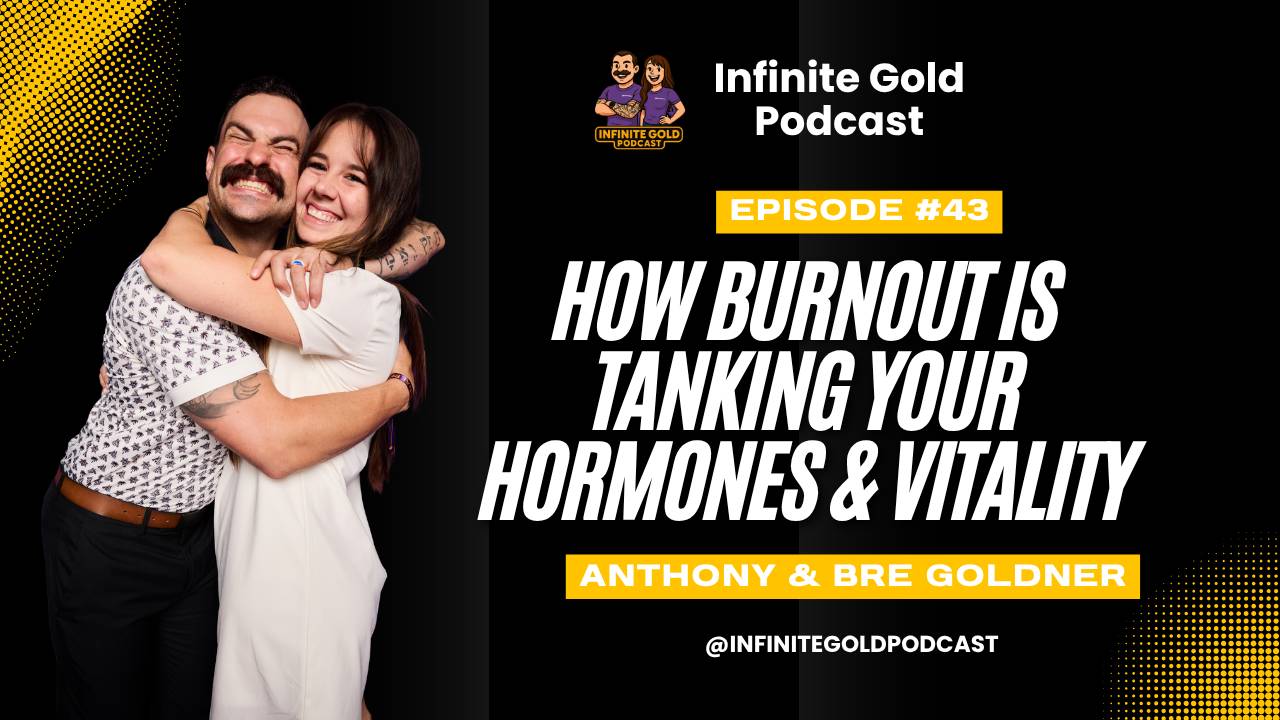Burnout Series Part 2: Why Is Stress Making Me Feel Like a Robot? (The HPA Axis, Cortisol & Hormones)
Oct 09, 2025
Introduction: The Shocking Science of Burnout
In Part 1 of our Burnout Series, we helped you identify if you were truly burnt out, just tired, or simply lazy, referencing the emotional symptoms defined by the Maslach Burnout Model. Now, in Part 2, we’re peeling back the curtain to reveal the science behind those feelings.
Why do you feel irritable, short-tempered, and emotionally spent? Why do high-pressure situations sometimes leave you feeling completely stagnant instead of energized?
Hosts Anthony and Bre Goldner dive deep into your body’s stress command center to explain what burnout is actually doing to your hormones and energy levels. If you've ever felt like your body simply won't cooperate when you need it most, this episode is your must-listen guide.
The Science Behind the Stagnation: The HPA Axis
The core of burnout lies in a critical system malfunction: the deregulation of the Hypothalamic-Pituitary-Adrenal (HPA) Axis.
Think of the HPA axis as your body's "stress dispatch center" or central command. Its job is to manage your cortisol levels—the key hormone in your fight-or-flight response.
The Burnout Effect: When you are chronically stressed and burned out, your cortisol is peaked for so long that your system eventually gets tired of jumping. As Anthony explains, when a true crisis hits, your cortisol doesn't spike as high as it should.
-
The Result: Instead of reacting quickly (fighting or fleeing), you become dysregulated. You feel that "robot" emoji: stagnant, still, and unable to process and react effectively to screaming kids, a demanding boss, or unexpected pressure.
Why Women Are "Complicated AF": Estrogen and the Stress Buffer
Bre explains that for women, burnout is significantly more complex due to hormonal cycles and life phases.
The Estrogen Connection: Estrogen acts as a natural shock absorber for stress.
-
When estrogen is steady, your body has a buffer and doesn't overreact to pressure.
-
However, when estrogen drops or fluctuates (during a monthly cycle, postpartum, or menopause), that buffer disappears.
This loss of a buffer means that stress and burnout can feel a hundred times more overwhelming than they should. For women, managing stress isn't just about your job; it’s about aligning your actions with your constantly shifting vitality.
Men and Burnout: The Drop in Testosterone (Andropause)
For men, who are primarily driven to protect and provide, chronic, high-level stress hits just as hard, often through different channels.
When men are constantly "red zoned," the prolonged high cortisol level can cause testosterone levels to drop—often too early in life. This excessive burnout can lead to a condition known as Andropause (the "manopause"), a phase of life where key hormones and energy drop prematurely.
The key symptom of this burnout phase is the lack of reaction. If something happens that should warrant a feeling, emotion, or reaction, and you have zero response, it’s a massive signal that you have been stressed and burnt out for too long.
Actionable Tactics: 3 Golden Nuggets to Reclaim Your Vitality
Burnout is not inevitable. Here are the three non-negotiable strategies Anthony and Bree use to reduce stress and build resilience:
-
Prioritize the Vitality Pillar: This is your non-negotiable health component. Sleep consistency is number one, as it naturally reduces cortisol. Combine this with regular movement (walking, bodyweight workouts), time outside, and nutrient-dense eating.
-
Practice the Mindset Shift: When in the middle of a rough day, tell yourself: “This is as bad as it's ever gonna be.” This powerful statement taps into optimism and resilience, immediately reframing the moment and reminding you that tomorrow is a new day.
-
Implement a Daily Brain Dump Ritual: To stop your brain from racing, try a simple Brain Dump at night. Get a notebook and write down: What went well? What do I need to work on? What am I grateful for? This clears the mental clutter and sets the stage for restorative sleep.
Stop Seeking "Balance"—Focus on Harmonious Alignment
The hosts reiterate that "balance" is a myth. What you need is Harmonious Alignment.
Focus on one thing at a time. If you're focusing on work, you must actively let go of the stressors from home. If you're at home with your family, you need to let go of work-related stress. Be where your feet are. This constant effort to compartmentalize reduces the 24/7 stress that spikes your cortisol and leads to burnout.
🔥 Next Step: Take the FREE Burnout Quiz
Are your hormones dysregulated? Are you sitting at a zero reaction level?
Anthony and Bree want to help you take the first step toward sustained energy and greatness.
Click the links to get immediate access to the FREE Burnout Quiz and comprehensive Guide. We have created both a Men's and Women's edition to address your unique needs.
SUBSCRIBE FOR WEEKLY LIFE LESSONS
We hate SPAM. We will never sell your information, for any reason.
